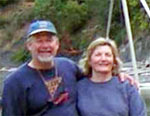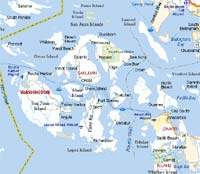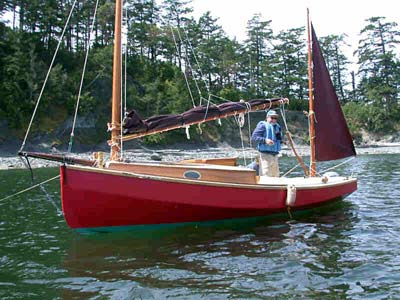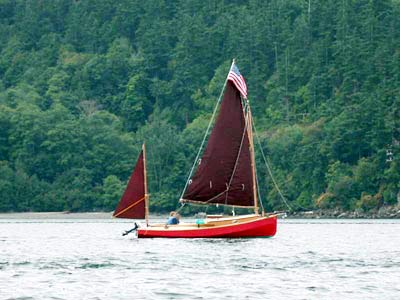| The Sucia
rendevous on July 10-12 of this year provided the
perfect beginning to a week in the San Juan islands of Washington
State's Puget Sound. My Bolger Chebacco ‘Full Gallop’
(named after my wife's favorite pastime) was completed only the
week before, and had only had time for a brief two-hour shakedown
in Dexter Lake beforeheading out for a week.
I started building my Chebacco after seeing the design in some
catalogues and reading all I could about Bolger’s designs.
It seems a bit of a departure from his usual ‘functional’
design scheme, with styling that I was later to understand was
strongly influenced by his wife, Susan.
Those of us at Sucia have all had the run-down
on the trip from the Lummi ferry dock, a fun and favorable intro
for some of us to saltwater sailing. And, while I had been there
previously, this was the first time I had been ‘on my own’
as far as navigating, tides, weather, etc. were concerned. Being
able to see Sucia in the distance helped with the first leg, but
I had limited experience with actually navigating my way to Prevost
Harbor on Stuart Island and beyond.
 Shay and I
Shay and I |
After the rendevous and bidding farewell to the last departing
sailors, my wife Shay and I daysailed the area between Orcas and
Sucia, and returned to Fox Cove, the original destination for
the Sail-in. It was now Monday, a ‘workday’, and the
bay was relatively quiet as the weekenders thinned out. Quiet,
that is, except for the NW wind blowing directly down the narrow
entrance between Sucia and Little Sucia, which served to stir
up the little cove. We made the best of it, relocating to the
lee of Little Sucia as best as we could, and enjoyed a quiet evening
on the beach, bundled against the cool breeze.
The run to Stuart the following morning was my first real challenge
in navigating. It’s something like 15 miles, I believe,
and not all that clearly visible against the background of islands,
mainland, and unidentified land masses. Our route intersected
the shipping lane, in an effort to avoid a reef near Waldron that
surprised me last year with strong currents and standing waves
apparently rising from nowhere. This time, I chose to skirt it
to the north, and chance the shipping lane instead, as the traffic
was very light. The trusty Honda (AKA ‘Iron Hoss’)
powered us thru the morning’s light air.
 (click image for large map)
(click image for large map) |
My GPS helped with navigation, but I try not to rely on it, choosing
to try to hone my chart and compass abilities. I can always use
GPS, but believe in the old ways so long as I’m not lost.
In this case, landfall was easy as we approached, but the harbor
entrance is well-hidden, and not at all clear on the GPS. I double-checked
the dead-reckoning, and finally saw a boat emerge from near where
my best guess was taking us – HA! SUCCESS!
Stuart Island is part public, and part private, with a lighthouse
at the NW tip that is said to be a great place to whale-watch
for the local pods of Orcas that frequent the area. It also has
a small school and museum on early island life, and great hiking
trails. After getting the hook down in a harbor full of mega-boats,
we took to exploring, hiking partway to the litehouse, and turning
back as old age and steep slopes got the better of us. We did
visit the little museum near the school, which was pretty cool
– some real insight into the early settlers, and an alternate
look at how resources were valued in the early years. It turns
out one of the major occupations on the island was cutting down
the old-growth doug fir and shipping it to San Juan for fuel for
the lime kiln. Hard to imagine using the best timber in the world
for firewood, but that’s how they cleared the island. A
very, very hard living, I would guess, as this was the age of
the axe and whipsaw, and they cut and split these huge trees into
4’ chunks. Of course, lots of fishing took place, too, but
life seemed pretty isolated – it still is for the 30 residents
of the island.
Back at the harbor, we boat-watched and were in turn watched
by the big boaters, as we scrambled about, cooking outside, lounging,
showering with our little solar shower, etc. as they seemed to
be unable to understand how we could have so much fun on such
a little boat. Unfortunately, few returned our friendly waves.
We’d been advised that Odlin Park on Lopez Is. might offer
a great sunset and good moorage, so weighed anchor the next morning,
planning a downhill run thru San Juan Channel south to Friday
Harbor and on to Odlin, which is just around (west of) Upright
Head from the Lopez ferry dock. As I cleared Prevost Harbor around
9:00 a.m., I was met by a dense wall of fog in the channel. Now
I understood why everyone has radar up here! I rigged my collapsible
radar reflector to the jib halyard, remembering the things I’d
read about how most radar couldn’t see little boats regardless
of those little reflectors. We idled slowly along, avoiding the
main part of the fogbank and trying to follow the path of power
boats that passed us and disappeared. Our visibility was actually
pretty good, staying to the west of the channel, but the fogbank
on the east side was ominously thick, and I knew that I needed
to ‘be east’ in the channel to avoid Speiden Channel.

'Full Gallop' at anchor (John Kohnen photo)
Speiden channel separates Stuart and Speiden Islands, and is
a somewhat messy little passageway, strewn with reefs and wrecks.
More importantly, its subject to a strong tidal ‘pull’,
augmented by a strong tidal ‘push’ from President’s
Channel due east of its inlet. This results in a strong tidal
current and rips that want to suck you down the channel if you’re
slow, or at least cause you to crab sideways to your desired course
to maintain headway. Call me paranoid, but I didn’t want
to get close to Speiden Channel, as our tides were strong by then,
and I didn’t want to buck a bunch of rips unless I had to.
After all, this was an unfamiliar boat and a second-hand engine
that I didn’t know well – I didn’t need lots
of challenges.
I’m not a religious man, but the fog DID lift on cue, allowing
me to cut east of Jones Is., and avoid most of the current. That
seemed fortunate, as I could see the standing waves in the channel
from the rips, sometimes only a few hundred yards away –
and I was a long way from the entrance to Speiden! One benefit
of my paranoia was that we skirted Wasp Passage, which looks like
a really great little passage; later, we were to find that the
services there (at Deer Harbor) are excellent, and its highly
recommended.
A brief tour of Friday Harbor showed us how the ‘other
half’ lived. Hard for a small-town boy to imagine that much
money in one place, but there it was. We didn’t stop, as
we didn’t want to shame all those giant ‘floating
clorox bottles’ as Jamie O. calls them, with our elegant
little red Chebacco. Friday Harbor is one busy place – sea
planes taking off, boats of all sizes and shapes, the ferry –
I kept my head on a swivel trying to keep from getting run into,
or embarrassing myself by holding up the ferry (I found out they
WILL wait!).
Odlin County Park is just across Upright Channel from Friday
Harbor, on Lopez Is. We picked up a mooring for $8, and hiked
the beach, which was fairly populated with car campers coming
over on the ferry. Odlin turned out to be a fairly rough anchorage,
due to the traffic on Upright Channel – pleasure boats,
ferries, etc. kept it churned up until evening. On review, I think
I could have chosen more wisely. Since we stay on the boat at
night, you’re very much captive to poor choices like this,
so I’ll be much wiser in the future.
Obstruction Pass is a narrow constriction leading to the ‘outside’
of the island group, and into Rosario Straits. Tides were increasing
during the week, and tidal flows were forecast to be strong. Obstruction
pass currents can exceed 5 knots, and given the heavy traffic
in the pass (like the ferry), I wanted to hit it right. This we
did perfectly the next morning, sailing from Odlin almost all
the way thru the pass until it turned south into the morning breeze.
Swallowing my pride, I fired up ‘Iron Hoss’ for the
last 100 yards or so, before re-setting the sails into a favorable
south wind to make our way north along the shore of Orcas to Doe
Bay.

'Full Gallop' at full gallop (John Kohnen photo)
Approaching Doe Bay, we met several sea kayakers, one of whom
volunteered his mooring to us for the night – a most generous
offer we accepted. Later, we found out he owned a large old wooden
catboat which he moored there, but was presently in the shop for
repairs. We’d visited Doe Bay resort many years earlier,
and rowed the inflatable in a marathon trip to the resort’s
inlet. Little seemed to have changed, except for the meal schedule
and the prices. Food was available only during lunch and dinner
hours, so we settled for $3 worth of soda pop, which is two small
servings. Later, we calculated that those sodas cost almost as
much as our outboard fuel for the whole week!
The Doe Bay mooring also proved to be rolly, more as a result
of the currents in the channel, as traffic was light. Again, its
a lesson learned that won’t be soon forgotten. Countering
this was the gorgeous scenery, supplemented by the low tides exposing
lots of marine life on the rocks near the bay – starfish
and other life that must thrive below normal tide range. The next
day’s trip along the west shore of Lummi was uneventful,
under motor and sail. My in-laws had graciously dropped my truck
and trailer at the take-out, and the biggest event was locating
our keys, which had disappeared into a week’s worth of clutter
in the cabin. I circled in the channel for nearly 1/2 hour while
we searched, before finding them right where we’d left them.
Overall, I consider the whole week a resounding success. We ate
well on our little coleman stove, had great sailing and weather,
and totally enjoyed the folks at the Sail-in. We found our way
around with chart and compass, and even found our way home. Full
Gallop performed flawlessly, including holding her own against
her gorgeous sisterships.

|

